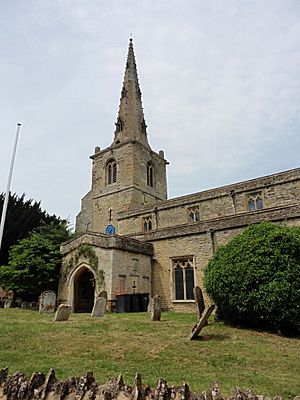Church of St Mary, Podington facts for kids
The Church of St Mary, also called St Mary the Virgin, is a very old and important church in Podington, Bedfordshire, England. It is so special that it is a Grade I listed building. This means it is protected because of its historical and architectural importance. It became a listed building on July 13, 1964.
Contents
Discovering the Church's History
The Church of St Mary has parts that are over 800 years old! Some of its oldest sections were built in the early 1200s. A report from 1912 described the church's main parts. These include the chancel (the area around the altar), the nave (where people sit), and aisles on both the north and south sides. It also has a south porch and a tall tower on the west side.
How Old Are the Church Parts?
Many parts of the church, like the chancel, the tower, and the arched walkways (arcades) in the nave, were built in the 13th century. The church has four bells, which were made between 1609 and 1618. The tall, pointed roof of the tower, called a spire, was built in the 14th century. It was changed a bit in the 1400s and 1500s. At one point, the spire was leaning and in danger of falling, but it was fixed in the 1800s.
Who Owned the Church?
Long ago, during the time of King Henry II (who ruled from 1154 to 1189), the church was given to the Canons Ashby Priory by Stephen la Leye. A priory is like a monastery. Later, when monasteries were closed down in England, the church became property of the King. In 1545, the right to choose the church's priest was given to Daniel Payne.
Important People Buried Here
The Church of St Mary is the final resting place for some notable people. One of them was Richard Orlebar, who passed away in 1733. He was once the High Sheriff of Bedfordshire, which was a very important local official. His wife, Diana Astry, is also buried here. She was known for writing about cooking and had owned a large house called Hinwick House.
The Church Organ and WWII Connection
The church has a pipe organ, which is a large musical instrument. This organ was carefully repaired by a group called the 92nd Bomb Group Memorial Association. This group is made up of people connected to the 92nd Bomb Group. This was a special group of airmen who were stationed at the RAF Podington airfield during World War II. They flew almost 300 important missions from that base, helping to protect the country.
See also
- Grade I listed buildings in Bedfordshire
References


